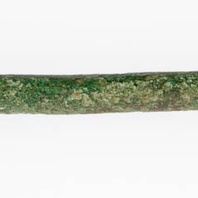
Viking Objects
Copper-Alloy Needle (CM. 1845-2008)
A cylindrical copper-alloy needle fragment with a broken shaft. Needles were a common textile tool and could be made from bone, metal or wood. They are usually associated with women and finds like this indicate that the inhabitants of the Viking camp at Torksey included women and children alongside the warriors of the Great Heathen Army.
Read More
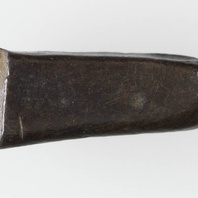
Viking Objects
Silver Ingot (CM.1789-2008)
This silver ingot was made by melting down worked silver cast into a rod and cut into sections. The Vikings arriving in England had a bullion economy where they paid for goods with silver that was weighed to an amount agreed between the buyer and the seller. Hacksilver and silver ingots are the most common evidence for their bullion economy. It took some time for the Scandinavian settlers to adopt a monetary economy like that of the Anglo-Saxons, and both systems were used simultaneously for a while before they fully adopted the new system. They were familiar with monetary economies but they treated coins as just another form of silver before adoption of a monetary economy.
Read More
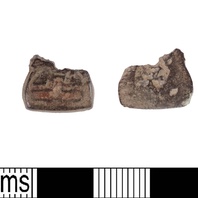
Viking Objects
Enamelled Irish Mount (LIN-9BCF25)
This item is a fragment of an Irish Early Medieval enamelled copper-alloy mount or strap-end. It is decorated with a rectangular perimeter of reserve metal which forms a ‘T’ shape. The recessed areas around and within it appear to contain degraded enamel. It is possible that it made its way to England prior to Viking incursions but it is equally likely, especially considering the Viking presence at Torksey, that the Vikings brought this mount with them as plunder after raiding various areas in Ireland.
Read More
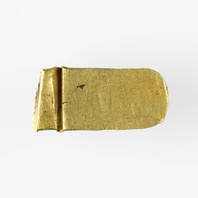
Viking Objects
Hack-gold (CM.1800-2008)
This rounded ingot terminal was cut from a larger rectangular ingot. Though rarer than hacksilver, this gold ingot formed part of the bullion currency used by Vikings in England and may be associated with their winter camp in Torksey.
Read More
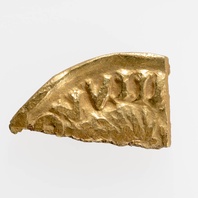
Viking Objects
Quartered Carolingian Gold Solidus (CM.163-2010)
This gold solidus of the Carolingian emperor, Louis the Pious (778-840 CE), was cut into pieces as hack-gold. Unlike the imitation gold solidus from the same era, it has not been cut carefully into quarters. Instead it has been snipped to the right size for weighing. Gold coins were used in the Carolingian empire until it adopted a silver standard.
Read More

Viking Names
Torksey
Torksey, in the Lawress Wapentake of Lincolnshire, is a difficult name. The second element is Old English eg ‘an island, dry ground in fen, raised land in wet area’, but the first element, though apparently a personal name, is hard to interpret. The most plausible suggestion is that it is the Old English male personal name Turoc. The Anglo-Saxon Chronicle for the year 872 records that Her nam se here winter setle. æt Turces ige ‘And it [the Great Heathen Army] took winter-quarters at Torksey in Lindsey, and then the Mercians made peace with the host’. Recent excavations and other archaeological finds at Torksey are helping to build up our understanding of what that here was and what it did during the winter of 872-3.
